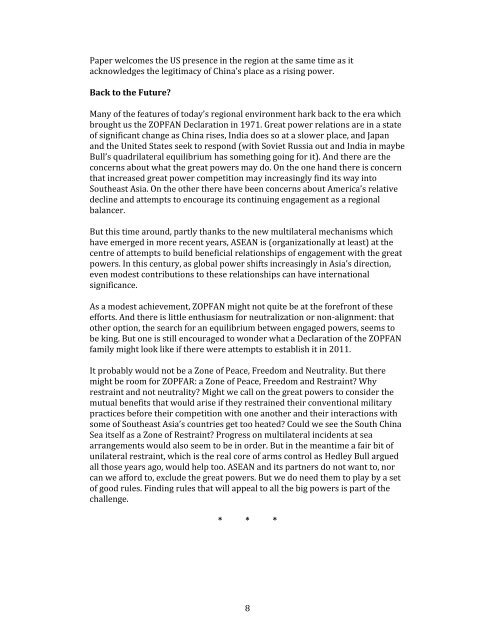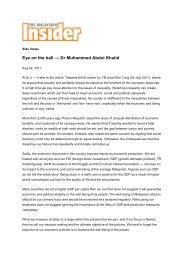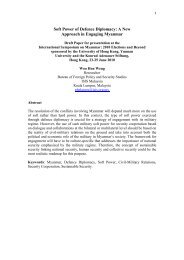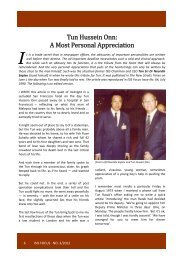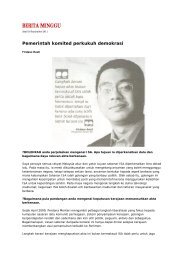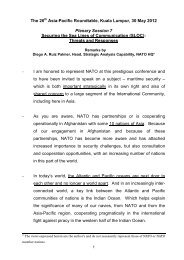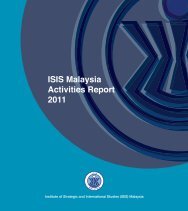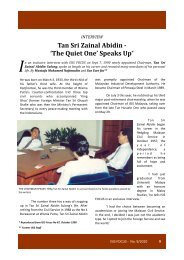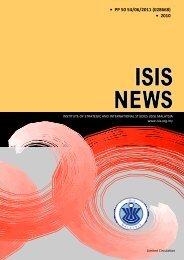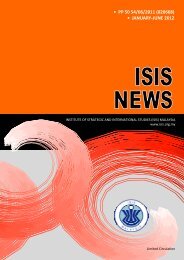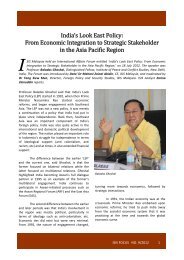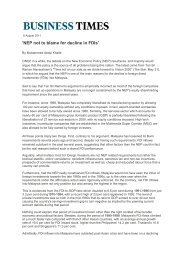ZOPFAN - ISIS Malaysia
ZOPFAN - ISIS Malaysia
ZOPFAN - ISIS Malaysia
You also want an ePaper? Increase the reach of your titles
YUMPU automatically turns print PDFs into web optimized ePapers that Google loves.
Paper welcomes the US presence in the region at the same time as it<br />
acknowledges the legitimacy of China’s place as a rising power.<br />
Back to the Future<br />
Many of the features of today’s regional environment hark back to the era which<br />
brought us the <strong>ZOPFAN</strong> Declaration in 1971. Great power relations are in a state<br />
of significant change as China rises, India does so at a slower place, and Japan<br />
and the United States seek to respond (with Soviet Russia out and India in maybe<br />
Bull’s quadrilateral equilibrium has something going for it). And there are the<br />
concerns about what the great powers may do. On the one hand there is concern<br />
that increased great power competition may increasingly find its way into<br />
Southeast Asia. On the other there have been concerns about America’s relative<br />
decline and attempts to encourage its continuing engagement as a regional<br />
balancer.<br />
But this time around, partly thanks to the new multilateral mechanisms which<br />
have emerged in more recent years, ASEAN is (organizationally at least) at the<br />
centre of attempts to build beneficial relationships of engagement with the great<br />
powers. In this century, as global power shifts increasingly in Asia’s direction,<br />
even modest contributions to these relationships can have international<br />
significance.<br />
As a modest achievement, <strong>ZOPFAN</strong> might not quite be at the forefront of these<br />
efforts. And there is little enthusiasm for neutralization or non‐alignment: that<br />
other option, the search for an equilibrium between engaged powers, seems to<br />
be king. But one is still encouraged to wonder what a Declaration of the <strong>ZOPFAN</strong><br />
family might look like if there were attempts to establish it in 2011.<br />
It probably would not be a Zone of Peace, Freedom and Neutrality. But there<br />
might be room for ZOPFAR: a Zone of Peace, Freedom and Restraint Why<br />
restraint and not neutrality Might we call on the great powers to consider the<br />
mutual benefits that would arise if they restrained their conventional military<br />
practices before their competition with one another and their interactions with<br />
some of Southeast Asia’s countries get too heated Could we see the South China<br />
Sea itself as a Zone of Restraint Progress on multilateral incidents at sea<br />
arrangements would also seem to be in order. But in the meantime a fair bit of<br />
unilateral restraint, which is the real core of arms control as Hedley Bull argued<br />
all those years ago, would help too. ASEAN and its partners do not want to, nor<br />
can we afford to, exclude the great powers. But we do need them to play by a set<br />
of good rules. Finding rules that will appeal to all the big powers is part of the<br />
challenge.<br />
* * *<br />
8


